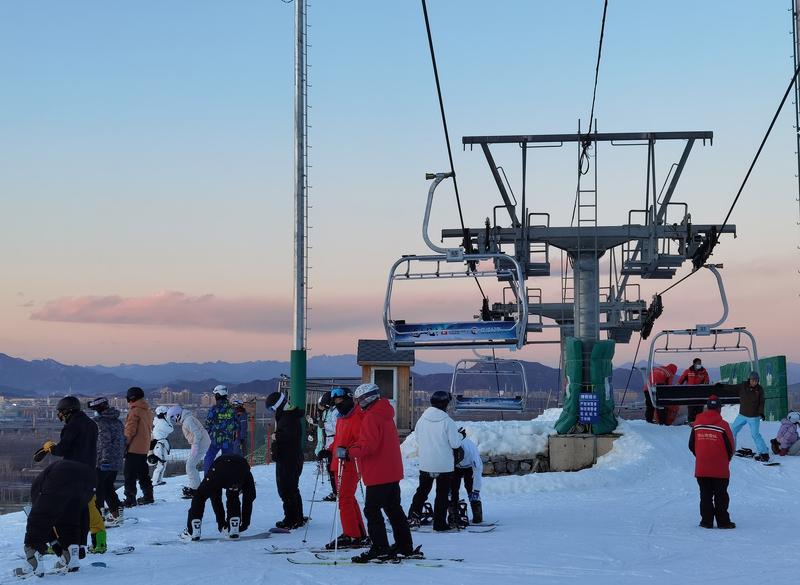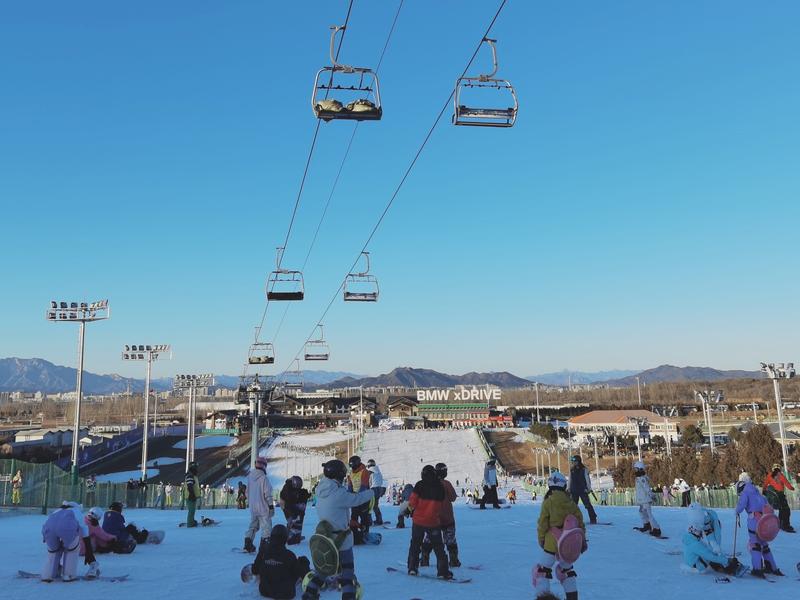Tackling the slopes is not for the fainthearted but the indignities and bruises are worth it, Cheng Yuezhu reports.
 Skiers prepare for their last run of the day at dusk, as the sky morphs from blue to pale yellow and then pink, at Beijing's Nanshan Ski Resort. (CHENG YUEZHU / CHINA DAILY)
Skiers prepare for their last run of the day at dusk, as the sky morphs from blue to pale yellow and then pink, at Beijing's Nanshan Ski Resort. (CHENG YUEZHU / CHINA DAILY)
If the raison d'etre for zoos is the close and safe observation of animals, then ski resorts provide a valuable insight into humans at play. At least that's what I gathered from my friend's impressions after she sat at the bottom of the slope for the entire afternoon in a state of self-doubt and ennui.
She went snowboarding with me under my elaborated descriptions of a newfound interest in snow sports, spurred on partly by the highly romanticized portrayal from Vladimir Nabokov's short story Wingstroke.
In the words of Nabokov, who has an eye for beauty in the most everyday and untended minutiae, good skiers exhibit an effortlessly elegant mien. "Hands nonchalantly thrust into the pockets of her leather jacket and her left ski slightly advanced, she sped off down the slope, ever faster, scarf flying, amid sprays of powdered snow," he wrote.
In his eyes, "all was merriment and azure" at the ski resort. It is true, based on my impressions of the Nanshan Ski Resort in Beijing. Every time I am there, it seems like a little world of its own, staying perfectly still as people come and go. The sky is always a deep azure, and the sun gleams on the snow-covered slopes, a reflective layer of sheer white.
This is where you can appreciate human wisdom, to acknowledge and put into warming context, this perfect solution to the chilliness and indolence of winter. Simply by combining the snowy hill, a couple of boards and the law of gravity, coldness is no longer an annual torment, and snow is not something that prevents people from going out, but an ideal environment that can be made use of to go even faster.
 Skiers and snowboarders speed down an intermediate trail in Beijing's Nanshan Ski Resort at nightfall. (CHENG YUEZHU / CHINA DAILY)
Skiers and snowboarders speed down an intermediate trail in Beijing's Nanshan Ski Resort at nightfall. (CHENG YUEZHU / CHINA DAILY)
The veterans will then remind you of the differences of human capacity. They speed down the advanced slopes while skillfully changing their course to avoid other people, fly over the jumps, and at last take an elegant curve and gracefully come, with the de rigueuer spray of snow, to a halt at the chairlift entrance.
You may also encounter other interesting people-social media influencers taking photos in their matching outfits and equipment, and occasionally celebrities, fully dressed against the elements, but still managing to be recognized by fans.
But it's often more fun to watch the novices, skiers who have trouble controlling their speed, and hence face the risk of becoming a "torpedo", an expression denoting an uncontrolled hurtle down the slope.
Those new to snowboarding are, on the other hand, prone to fall over in ways that may appear to defy the laws of physics. When they lose their balance, they might fall on their backs or knees, unable to get up; when they catch an edge, they might take quite a few tumbles down the slope; and when they get off the chairlift, they might crash into one another. Of course, I know because of personal experience.
This is where "the little tortoise "comes in handy. The tortoise-shaped plushy that people wear on their butts and knees as cushions has developed its own air of celebrity at ski resorts across China over the past several years.
Whoever first had the idea of hanging a stuffed toy on their buttocks must surely be a genius. Even though they are considered by some to be unprofessional or clumsy, they are thick and soft and provide cushioned comfort to most coccyx-crunching tumbles.
 Novice snowboarders often wear "the little tortoise", a plush piece of protective gear, on their butts and knees. (CHENG YUEZHU / CHINA DAILY)
Novice snowboarders often wear "the little tortoise", a plush piece of protective gear, on their butts and knees. (CHENG YUEZHU / CHINA DAILY)
As well as the original green tortoise, this plushy protective gear now comes in various shapes and colors, including bears, pandas and cartoon characters. But the tortoise is undoubtedly the classic, and from an amateur's perspective, its dome shape seems to be able to offer the best protection.
The problem is, you'd struggle to squeeze all three of them into the chairlift, and some may find wearing them makes it harder to maintain balance. My friend, for example, found it difficult to even get up from her snowboard, especially so in the afternoon when the slopes became icy.
She then sat at the bottom corner of the slope, which was in her words "a gathering spot for the hopeless".Quite a few people, having lost their motivation to get up again, had taken off their skis or snowboards, and opted, instead, to enjoy their time taking photos with their friends.
Though tempting, I decided to savor the rest of the afternoon with a few more rounds on the hill. One foot on the board, I trudged toward the chairlift entrance, queued for more than 10 minutes, squeezed the tortoises into the chairlift and took my first tumble getting off it.
My personal favorite, an intermediate trail at Nanshan Ski Resort, attracts slightly fewer people and has the ideal steepness to practice snowboarding. I tried to take linked toe-and-heel turns down the slope. The journeys were almost never smooth.
Each round usually involved me taking a few standard tumbles, sitting on the slope reflecting on my life decisions, and occasionally falling hard on the ground and scraping a shower of snow dust when catching an edge.
But the last trip of that particular day was able to compensate for all the previous torment. The sun was kindly offering its last golden blaze of the day, and the sky morphed from blue to pale yellow and then pink. I slid down the hill at full speed without trying to control my posture, as the villages in the distance, covered by an ashy pink and golden sheen, gave a sense of apocalyptical beauty. I felt Nabokov's "ineffable happiness" flowing over me, and that perhaps life could actually be "a splendid ski run", of speeding and tumbling, passing people, and a world of surreal beauty and immense possibility on the horizon.
Contact the writer at chengyuezhu@chinadaily.com.cn


